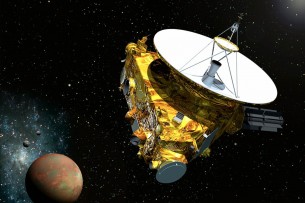
No matter how it may have looked to some observers, the team of scientific investigators that submitted a paper to Planetary and Lunar Science was not high on moonshine. They meant it when they seriously argued that Pluto and other bodies in the solar system – including the moon- should be upgraded to planetary status as well. Presumably with all the dignity and respect this designation bestows. Planetary scientist Alan Stern, NASA’s principal investigator for the historic New Horizons interplanetary space probe that visited Pluto last July, was counted among the authors of the scientific paper. One can only imagine his pique when the International Astronomical Union (IAU) chose to downgrade Pluto’s planetary status only months after New Horizons began its historic nine-year journey to visit what, at the time, was the solar system’s last planetary outpost. For Stern and colleagues, the IAU’s idea of what a celestial body must do in order to be awarded full membership in the planetary club is bogus. The IAU ruled that planets must orbit the sun and have enough mass to gravitationally form a round shape. The union also stipulated that a planet must have cleared the neighborhood around its orbit, which left Pluto and other Kuiper belt planetoids outside in the cold because they failed the housekeeping test. Stern and his colleagues argue that the geophysics of a celestial body should determine whether it is a planet – not the arbitrary dictates of the IAU. According to their reasoning, not only do Pluto and other Kuiper belt objects belong in the fold the same can be said for objects much closer to home. In an article for The Conversation, Stephen Pumfrey, PhD, a history professor at Lancaster University in the U.K., says moderns are “so used to thinking of the Earth’s satellite as a moon that the idea it could be a planet is truly shocking. But ancient Greek and medieval astronomers all assumed that the moon was indeed a planet.
“Ancient observers knew that the stars maintain their relative positions night after night: they saw constellations such as Leo or Gemini just as we do, but they also saw seven heavenly bodies slowly change their positions, wandering from west to east through the sky.” Prof. Pumfrey believes the moon was of special interest because its proximity made it the only planet with visible features – the so called “man in the moon.” And he points out that Aristotle (384 – 322 BCE) asked several questions about the moon, including why we always see the same face and never the far side? “It’s a good question. Astronomers now explain it as the result of gravitational forces between planets and large moons, and call it tidal locking,” he said.
According to the Lancaster University educator Aristotle had a different idea. He thought it proved the locked moon had no innate ability to rotate or move, and assumed the same was true of all planets. “Aristotle thought Planets only move because they are carried in a circle. This was the origin of an elaborate medieval cosmology in which the planets and stars are rotated in a nest of celestial spheres. Had our moon not been tidally locked astronomy might have taken a different path,” Pumfrey opined. “With Copernicus’ heliocentric astronomy, published in 1543, the moon ceased to be a typical planet…It was now Earth’s satelles, meaning servant, from which our word satellite derives.” he said. Pumfrey says that when Galileo trained his telescope on Jupiter in 1610 he discovered four satellites. This was lovely news for Copernicus, but not so good for Luna. It was no longer THE moon but one of five, a number that since has grown to the 147 moons we know orbit planets in our solar system and an additional 17 awaiting confirmation. “In Galileo’s time the moon was the subject of an argument between the new cosmologists, who saw it as earth-like with seas and lands, and the old astronomers who insisted that it was a proper, perfect heavenly body,” he added.
With his new definition of a planet, Pumfrey believes Stern has renewed that battle. According to Stern, “the IAU may find its definition of what a planet is to be perfectly useful, but our geophysical definition is more useful for planetary geoscience practitioners, educators and students.” Stern’s definition may work better for some astrologers because it is celestially more inclusive. But astrology is focused not so much on what things are made of but on what they mean. Modern astrology envisions the individual as being uniquely positioned at the center of her/his own personal universe, growing and adapting as seasons pass and personal planets progress. Whether planets are rotated in a nest of celestial spheres or moved about in less exotic ways doesn’t change the way they fundamentally impact people’s lives in meaningful ways.